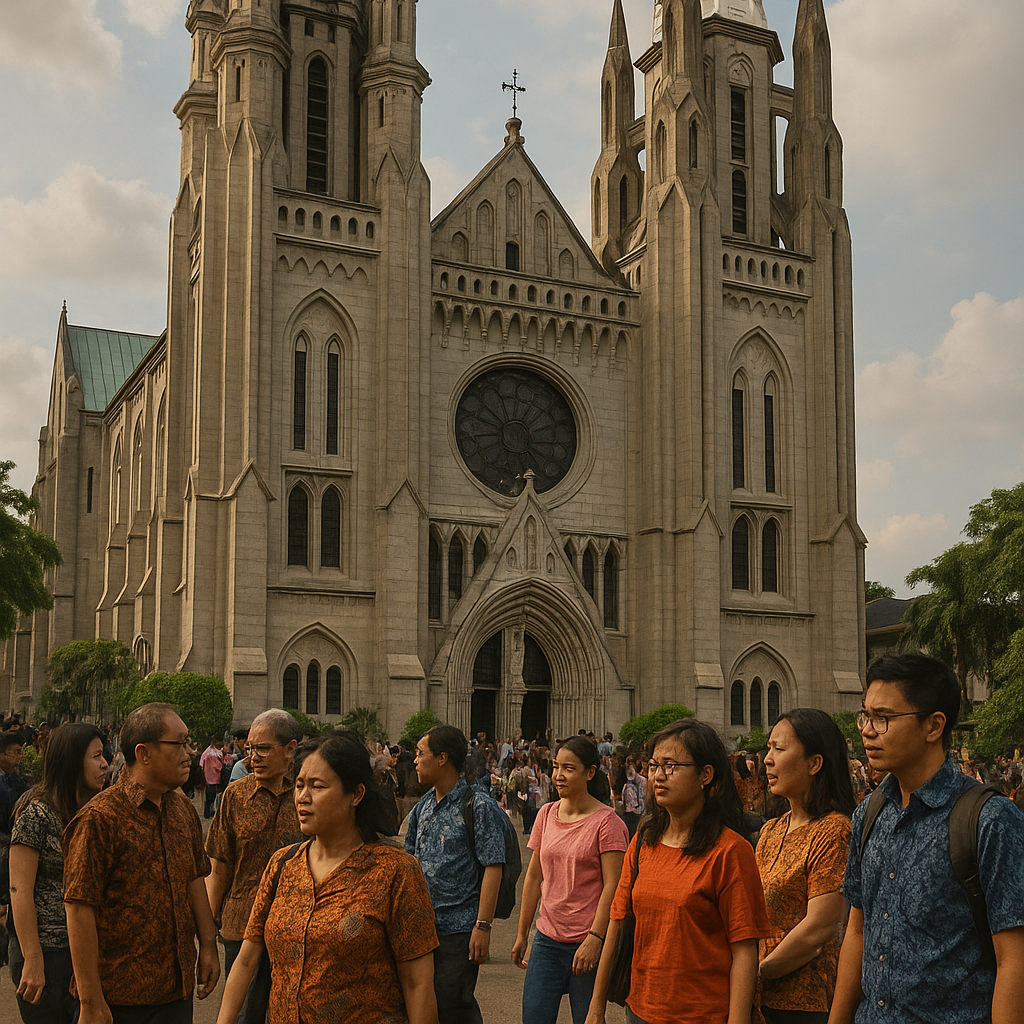The Church of Assumpta Kupang: From a Stone Foundation to the Firmness of Faith
theolingua.id – Santa Maria Assumpta Parish is one of the parishes in the Archdiocese of Kupang, located at Jalan Perintis Kemerdekaan Number 9, Kupang, East Nusa Tenggara. The parish complex consists of a main church, a pastor’s hall, a parish secretariat office, and a multipurpose hall which is the centre of Catholic activities in the area.
The Church of Santa Maria Assumpta is known for its artistic architectural design, as well as the presence of the Gua Maria (Mary’s Cave) and the Adoration Room, which add to the religious atmosphere and comfort for worshippers. However, behind the grandeur of this church, there is a long history of struggle by the congregation to build a proper place of worship from 1979 to 1988.
The Initial Struggle to Build the Church
In 1979, Catholics in the Oepoi, Kayu Putih, Oebufu, and Tofa areas began to grow rapidly. Initially, they worshipped in temporary places because they did not have their own church. The growing number of parishioners encouraged the Archbishop of Kupang Diocese, together with the parish priest and the Parish Priest Council, to plan the construction of a permanent church.
This decision was strengthened by the issuance of the Pastor Decree (SKP) by His Excellency Bishop Gregorius Monteiro, SVD of the Diocese of Kupang on 13 February 1988 with Number 1/201/1988. After going through various preparations and struggles, the groundbreaking ceremony was held on 12 August 1988, coinciding with the celebration of the parish’s first anniversary. The construction of the church involved all the congregation with a spirit of mutual cooperation and unceasing prayer.
On 5 October 1988, Brother SVD and the workers began installing the church foundation stakes. The process of digging the foundation and installing 38 main pillars was carried out on 10 October 1988. With a strong spirit of faith and spirituality, the entire process of building the church was carried out with dedication until it was finally completed and consecrated on 8 December 1989.
Church Architecture and Structure
The Church of Santa Maria Assumpta was built on a solid stone foundation, reflecting the resilience and steadfastness of the faith of the people who founded it. The building design adopts a large space structure with free columns, giving a spacious and comfortable impression to the congregation during worship. Strong architectural elements are also evident in the shape of the roof and the arches of the church which are decorated with parapets, adding to the aesthetic value of this building.
The main door of the church is located on the west side, facing the sunset, symbolising hope and serenity. The design concept emphasises not only the beauty of the architecture, but also prioritises comfort and tranquillity for worshippers. The interior of the church is designed to create a solemn atmosphere, allowing each congregation to feel spiritual peace in every liturgical celebration.
The Role of the Pastor and the Initial Community
The first pastor to lead the Santa Maria Assumpta Parish was Father Julius Bere SVD, accompanied by Chaplain Father Ebed, Pr. They played a major role in guiding the congregation and coordinating various religious activities during the early days of the parish’s establishment.
Before having their own church, members of several basic community groups (KUB) in the area initially attended mass at the Bishop’s Palace. In 1984, after the construction of the Santo Rafael Oepoi Seminary was completed, the building was used as a temporary mass location until the church was finally completed.
Dynamics and Development of the Community
Over time, the number of parishioners at Santa Maria Assumpta Parish has continued to grow. Based on data from 1988, there were around 500 families with a total of 6,000 parishioners belonging to 30 grassroots groups. The parish has continued to develop with various pastoral, social, and educational activities for the community.
The diversity of the congregation, which comes from various regions in East Nusa Tenggara, makes this parish a place for encounters and togetherness in the practice of the faith. The professions of the congregation are also very diverse, ranging from civil servants, lecturers, businessmen, craftsmen, drivers, to other informal workers.
Conclusion
The Santa Maria Assumpta Parish Church in Kupang is not only a place of worship, but also a symbol of the struggle and unity of Catholics in the region. Since its founding in 1979, the church has witnessed the perseverance of the congregation in building a proper place of worship. With full enthusiasm for mutual cooperation and firm faith, the congregation slowly built a strong foundation, both physically and spiritually, to support their religious life.
Over time, St Mary of the Assumption Church continued to grow, not only as a centre of worship, but also as a place for faith formation and social activities for Catholics in Kupang and the surrounding area. Various spiritual activities, such as Eucharistic celebrations, catechesis, and pastoral services, further strengthen the role of this church in the lives of the congregation. With a long historical legacy, this church remains a mainstay in upholding the values of togetherness and the Catholic faith in the region.







